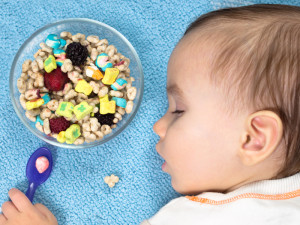When to Ignore Messy Eating. When to Nip it in the Bud.
/I’m often asked about kids' messy eating. Parents often wonder what’s normal and at what age kids will learn to use utensils. Recently I received this question from a Mom:
My question is regarding messy eating. My daughter (just turned 4) often eats with her hands and then has food obviously all over her hands but also on her face from ear to ear. She also plays with her food a bit (ie: bites a few holes in her bread and then pauses to see what shape she has made). How much emphasis should I put on eating neatly with a fork and spoon and how do I do this or should I just be happy that she’s eating?
It's normal for preschoolers (3 - 5 year olds) to eat with a combination of their hands and utensils. Most are still working on the dexterity involved in using utensils. They're curious about the world, so yes, they'll likely explore their food too (like the example you give with the bread).
As long as her behaviour is coming from a place of eating and interest in her food, don't sweat this mess. Because we want her to continue feeling confident with eating. We don't want to make her feel self-conscious about the way that she eats.
Teach through role modelling. Have an adult join her at as many meals and snacks as possible. Her internal drive to grow up will motivate her to copy your use of utensils and other actions at the table (e.g. wiping your mouth with your napkin when you finish eating).
In the meantime, go ahead and start teaching other manners like saying please and thank you, taking turns to speak during a conversation, asking to have someone pass you the peas, and asking to be excused when finished eating.
On the other hand, pay close attention to see if her behaviour is motivated by naughtiness. That is, if she's acting out and purposely taking actions to get negative attention. You'll recognize this right away. If so, then do nip the behaviour in the bud and explain that we don't play with our food.















 Recently a parent asked me this question: “How much cow’s milk to offer toddlers. Do you allow them to regulate/drink as much as they want or just fill the cup up once and then when it's empty that's it? Being only 17 months, he can fill up pretty quick on milk during the meal, but I also don't want to be taking it away. I would prefer to just allow him to self regulate, but not sure what to do once the sippy cup is empty.”
Recently a parent asked me this question: “How much cow’s milk to offer toddlers. Do you allow them to regulate/drink as much as they want or just fill the cup up once and then when it's empty that's it? Being only 17 months, he can fill up pretty quick on milk during the meal, but I also don't want to be taking it away. I would prefer to just allow him to self regulate, but not sure what to do once the sippy cup is empty.”
 {
{
 It happened again yesterday. I was leading a workshop and a parent asked me: “Is it wrong to give my child smoothies with veggies in them? Is this considered hiding veggies?” Rarely a workshop goes by without a parent asking me about smoothies for their picky eater kids. They’re such a popular trend these days. While I touched on this in last week’s blog post; it’s such a common question that I get about healthy snacks for kids that I thought that it was worthwhile to expand on it today. And, share some ideas for smoothie ingredients.
It happened again yesterday. I was leading a workshop and a parent asked me: “Is it wrong to give my child smoothies with veggies in them? Is this considered hiding veggies?” Rarely a workshop goes by without a parent asking me about smoothies for their picky eater kids. They’re such a popular trend these days. While I touched on this in last week’s blog post; it’s such a common question that I get about healthy snacks for kids that I thought that it was worthwhile to expand on it today. And, share some ideas for smoothie ingredients. I shared this post previously with the
I shared this post previously with the  You’ve probably heard that it’s great to get your kids to help you in the kitchen to learn cooking skills, instill healthy eating habits, and more.
You’ve probably heard that it’s great to get your kids to help you in the kitchen to learn cooking skills, instill healthy eating habits, and more.